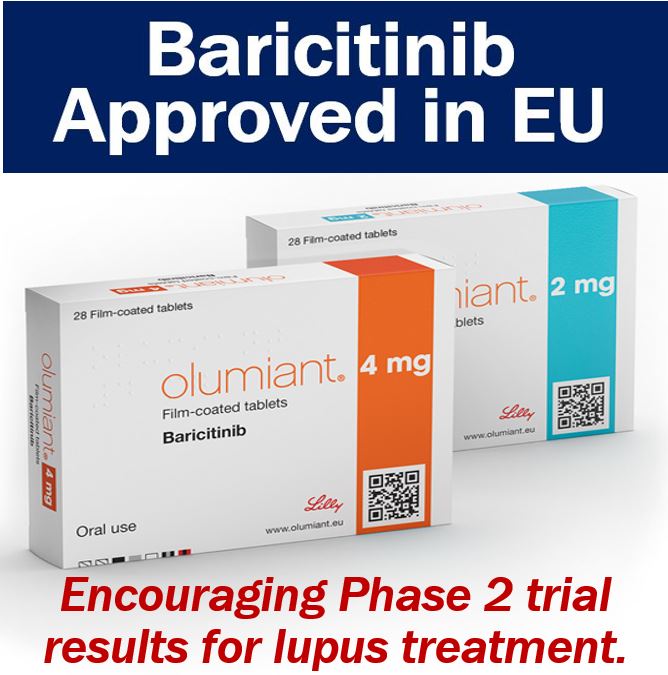A Phase 2 study of Baricitinib showed that lupus patients with a skin rash or arthritis benefited from treatment. Eli Lilly and Company and Incyte Corporation are developing baricitinib (trade name Olumiant).
A statistically significant percentage of patients who received 4 mg of Olumiant benefited. Specifically, they achieved resolution of their lupus-related rash or arthritis at week 24 compared to patients on a placebo.
Researchers published details of the study as well as their findings in The Lancet (citation below).
Lotus Mallbris, M.D., Vice President of Immunology Development at Lilly Bio-Medicines, said the following regarding lupus treatments:
“Despite existing treatments for SLE management, there is a significant need for innovation and alternative treatment options to help patients manage their disease.”
“We are very happy to share these data suggesting baricitinib’s impact on disease activity and symptoms that matter to patients, including joint pain, and look forward to further investigation of this important new compound in Phase 3 trials.”
Phase 3 to start soon
Lilly says it plans to start Phase 3 trials of baricitinib for the treatment of lupus in the second half of this year. The Phase 3 trials evaluate the efficacy and safety of the drug.

Baricitinib Phase 2 trial
In the trial, 314 patients were randomly selected to receive either a placebo, baricitinib 4 mg, or 2 mg.
A press release that Lilly published on 19th July said:
“Patients treated with 4 mg of baricitinib experienced improvements compared to placebo on several pre-specified secondary endpoints.”
“Compared to placebo, a statistically significant greater proportion of patients treated with 4 mg of baricitinib experienced lower overall disease activity at week 24 as measured by the SLE Responder Index 4 (SRI-4).”
Baricitinib 4mg vs. placebo groups
Significantly more patients on the 4 mg dose achieved a state of low disease activity than those on the placebo. They also experienced a decline in pain from baseline.
In the placebo, baricitinib 2mg, and 4 mg groups, 21%, 18%, and 17% respectively stopped therapy through the 24-week treatment period.
Adverse events
The most common adverse events among the baricitinib groups were respiratory and urinary tract infections.
The trial registered 5% serious adverse events (SAEs) among the placebo patients. Among the baricitinib 2 mg and 4mg participants, SAE frequency was 10.5% and 9.6% respectively.
Serious infections were the most serious adverse events. In the baricitinib 4 mg group, there was one case of deep vein thrombosis.
There were no deaths or malignancies in the trial. There were no major adverse cardiovascular events, serious herpes zoster infections, or cases of tuberculosis.
Lead author, Daniel Wallace, M.D., Professor of Medicine and Associate Director of the Rheumatology Fellowship Program at Cedars-Sinai Medical Center, said:
“Systemic lupus erythematosus is a chronic, multi-organ autoimmune disease characterized by periods of flare and remission and is associated with a variety of symptoms, including joint pain and swelling.”
“Notably, these Phase 2 data showed improvements in pain associated with SLE, one of the more challenging symptoms for these patients, and I look forward to the investigation of baricitinib in Phase 3 trials for SLE.”
In an Abstract preceding the main article in The Lancet, the authors wrote:
“The baricitinib 4 mg dose, but not the 2 mg dose, significantly improved the signs and symptoms of active systemic lupus erythematosus in patients who were not adequately controlled despite standard of care therapy, with a safety profile consistent with previous studies of baricitinib.”
“This study provides the foundation for future phase 3 trials of JAK1/2 inhibition with baricitinib as a new potential oral therapy for systemic lupus erythematosus.”
Lupus – some facts
Lupus affects many parts of the body. Therefore, there is a wide range of possible signs and systems. Doctors say that no two lupus cases are ever the same.
Consequently, treatment options for lupus patients vary considerably.
Researchers are not sure what causes lupus. However, they believe it is due to a combination of genetic, hormonal, and environmental factors.
Air pollution and sunlight, for example, are environmental risk factors.
More than one-third of all patients saw at least six different doctors before getting the correct diagnosis.
The global lupus market, which is already huge, is growing rapidly, especially in Europe and North America.
Citation:
‘Baricitinib for systemic lupus erythematosus: a double-blind, randomised, placebo-controlled, phase 2 trial,’ Prof Daniel J Wallace, MD, Prof Daniel J Wallace, Prof Richard A Furie, MD, Prof Yoshiya Tanaka, MD, Prof Kenneth C Kalunian, MD, Prof Marta Mosca, MD, Prof Michelle A Petri, MD, Prof Thomas Dörner, MD, Prof Mario H Cardiel, MD, Prof Ian N Bruce, MD, Elisa Gomez, MS, Tara Carmack, MS, Amy M DeLozier, MPH, Jonathan M Janes, MD, Matthew D Linnik, PhD, Stephanie de Bono, MD, Maria E Silk, PharmD, Prof Robert W Hoffman, DO. The Lancet, Volume 392, No. 10143, p222–231, 21 July 2018. DOI: https://doi.org/10.1016/S0140-6736(18)31363-1

